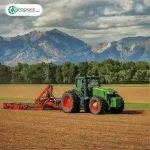Introduction
Baler twine is the beating heart of the mechanized packaging process for agricultural products such as hay and straw. Choosing the right baler twine directly impacts packaging quality, ease of transportation, and waste reduction. In this comprehensive article, we will explore the types of baler twine based on their constituent materials and the vital importance of baler twine tensile strength to guide you in selecting the best option for your needs.
Which Twine is Right for You?
Baler twines have different characteristics based on the raw materials used in their production. Understanding these differences will help you choose a twine that suits your farm conditions and the type of crop you are dealing with.
Polypropylene (PP) Baler Twine:
Polypropylene baler twine is one of the most popular and cost-effective options on the market. This type of twine, due to its light weight and high resistance to moisture and chemicals, is very suitable for packaging hay and straw in moderate weather conditions. If you are looking to buy affordable baler twine with acceptable performance, polypropylene can be a suitable option.
Polyester (PET) Baler Twine:
Compared to polypropylene, polyester baler twine has higher tensile strength and exceptional resistance to abrasion. These features make polyester twine an ideal option for packaging heavy and dense bales, as well as for tough farm conditions. If durability and reliability in packaging are your priority, the best baler twine will be made of polyester.
Combined Baler Twine:
Some manufacturers use combined baler twine to provide the best performance in specific conditions. These twines, by combining different polymeric materials, strive to create a balance between strength, flexibility, and price. To find high-quality baler twine that meets your specific needs, reviewing the specifications of combined twines is also recommended.
The Vital Importance of Baler Twine Tensile Strength:
The tensile strength of baler twine refers to the maximum force that the twine can withstand before breaking. This feature is the most important factor in ensuring the quality and safety of agricultural product packaging.
Maintaining Bale Integrity:
Baler twine with adequate tensile strength is able to withstand the pressure resulting from the compression of hay or straw and prevents bales from opening and falling apart. This ensures easy and trouble-free transportation and storage and prevents product waste.
Preventing Twine Breakage and Increasing Work Efficiency:
Baler twine breakage during the packaging process not only stops the baler but also wastes a significant amount of time and money. Using high-strength baler twine minimizes the occurrence of these problems and helps increase work efficiency.
Choosing the Right Twine Based on Bale Weight and Type:
For packaging heavier and denser bales, it is essential to use strong baler twine with high tensile strength. Choosing twine appropriate to the weight and type of bales produced prevents accidents and damage to the products.
Units of Measurement for Baler Twine Tensile Strength:
The tensile strength of baler twine is usually measured in units such as pounds per knot (lbs/knot) and kilogram force (kgf). When buying baler twine, pay attention to these units to select a twine with the required strength.
Conclusion:
Choosing the right baler twine is a smart investment for every farmer and professional in the field of agricultural harvesting. By considering the types of baler twine in terms of their constituent materials and ensuring sufficient tensile strength, you can guarantee high-quality packaging, easy transportation, and reduced waste. To buy the best baler twine, pay attention to the specific needs of your farm and the type of crop, and by reviewing the technical specifications of different products, make an informed choice.





